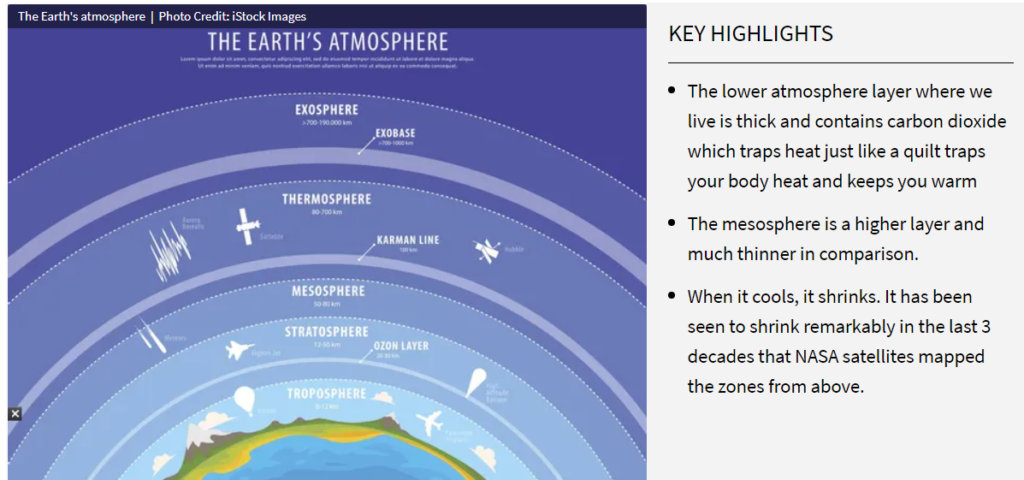Climate change is such an intertwined and complex phenomenon that it cannot be fixed by fixing just one faultline. Primarily, mankind must stop overheating the Earth as it otherwise has terrible ramifications.
Climate change has begun to dent the Earth’s atmosphere and it is showing. NASA scientists have now studied and mapped the mesosphere (a layer of the atmosphere) that is much thinner than the part of the atmosphere we live in. It is because of this thinness that the impacts of increasing greenhouse gases, such as carbon dioxide, differ from the warming we experience at the surface, reports the Science Tech Daily. The SciTechDaily report also cites one researcher having compared the atmospheric layer where we live, the troposphere, to a thick quilt.
“Down near Earth’s surface, the atmosphere is thick,” James Russell told Lina Tran of NASA’s Goddard Space Flight Center who has written in SciTechDaily. Russel is a study co-author and atmospheric scientist at Hampton University in Virginia. “Carbon dioxide traps heat just like a quilt traps your body heat and keeps you warm.”
Why this shrinking action in Mesosphere?
Lina Tran, NASA’s Goddard Space Flight Center writes in SciTecDaily:
- In the lower atmosphere, there are plenty of molecules in close proximity, and they easily trap and transfer Earth’s heat between each other, maintaining that quilt-like warmth.
- This quilt-like trapping of heat disallows most of Earth’s heat to escape to the higher, thinner mesosphere where the molecules are few and far between.
- Since carbon dioxide also efficiently emits heat, any heat captured by carbon dioxide sooner escapes to space than it finds another molecule to absorb it.
- Going by that principle, when pollution on Earth increases the greenhouse gases like carbon dioxide (blame mankind for the huge carbon footprint) – means more heat is lost to space — and the upper atmosphere cools.
- When air cools, it contracts, the same way a balloon shrinks if you put it in the freezer.
NASA scientists are not shocked by proof that the mesosphere is cooling and contracting. For years, “models have been showing this effect,” said Brentha Thurairajah, a Virginia Tech atmospheric scientist who contributed to the study. “It would have been weirder if our analysis of the data didn’t show this.”
Older studies did note the cooling but it is the collation of data accumulated over a timespan (over 29 years, using all three data sets) that shows the upper atmosphere contracting and awakens scientists to the upper atmosphere’s complicated changes.
The team analyzed how temperature and pressure changed over this almost 3-decade-long spell which covered the summer skies of the North and South Poles. They examined the stretch of sky 30 to 60 miles above the surface. At most altitudes, the mesosphere cooled as carbon dioxide increased. That effect meant the height of any given atmospheric pressure fell as the air temperature dropped. In other words, the mesosphere was contracting.
Do the mesosphere’s changes affect us on Earth?
The upper boundary of the mesosphere, about 50 miles above Earth, is where the coolest atmospheric temperatures are found. It’s also where the neutral atmosphere begins transitioning to the tenuous, electrically charged gases of the ionosphere.
Even higher up, 150 miles above the surface, atmospheric gases cause satellite drag, the friction that tugs satellites out of orbit. Satellite drag also helps clear space junk. When the mesosphere contracts, the rest of the upper atmosphere above sinks with it. As the atmosphere contracts, satellite drag may wane — interfering less with operating satellites, but also leaving more space junk in low-Earth orbit.
Space debris is a serious threat to future space exploration and also to the ongoing space programmes. If the assistance of the mesosphere in clearing space junk wanes, it could hamper mankind’s endeavour to explore the universe.
Article Credit: timesnownews
